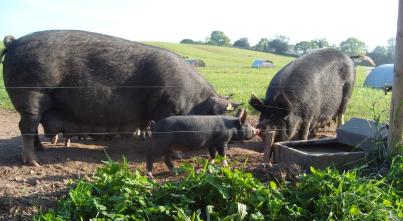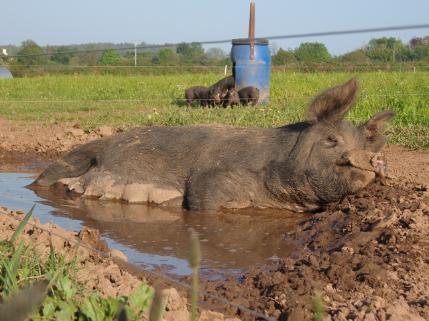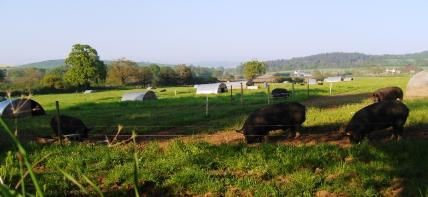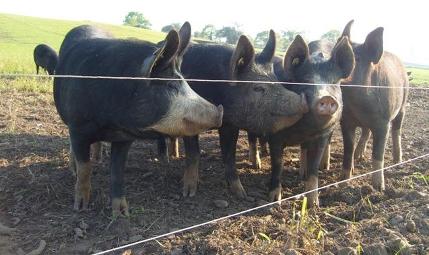We have one of the largest, all outdoor, traditional breed herds in the country. Our pigs are kept outside for their whole life, contained by a pulse electric fence. They have free access to insulated arks with plenty of straw, fresh water and the freedom to root through the soil; just what pigs love to do.
Our pedigree Berkshire pigs are an all black breed with white feet, a white blaze on the face and a white tip to the tail. They have a great personality, very good temperament and good mothering qualities which make them ideal for rearing piglets outside.
The light sandy soil at Duckaller Farm is ideal for pig production and they are an integral part of Duckaller Farm, serving an important role in our efforts to create a sustainable farming system by;
- Providing natural soil fertility
- Clearing perennial weeds, particularly couch grass and docks, and volunteer crops, especially root vegetables
- Utilising the straw from cereal crops
We do:
- Always keep our pigs outside, unless they need special treatment
- Feed and check our pigs every day
We don't:
- Use antibiotics unless absolutely necessary
- Dock our pigs' tails
- Clip our piglets' teeth
- Castrate our male pigs
Sows are weaned (separated from the piglets) and moved into a small paddock on their own next to the boar and other dry sows (pregnant pigs). This gets the main group familiar with the sow so she can mix with the others in a few days with a reduced risk of bullying. The sow will come onto heat within a few days of being near the boar. If she conceives then she will give birth in 3 months, 3 weeks and 3 days time. (112-115 days time). If she doesn't conceive then she will come onto heat again 3 weeks later. The sows are moved into their own individual paddock a couple of weeks before giving birth in order to increase their food intake and for the sow to make their 'nest' before giving birth. Dry sows and boars are fed 2 -3kg/day, the equivalent of 3 loaves of bread.

Weaners are piglets that have been separated from their mothers at around 5 weeks of age because they are able to eat enough solid food to survive on their own. They are fed a high protein, small-pelleted feed in a hopper in their arks. They are allowed to eat as much as they can in order to grow quickly. At 5 weeks old, and weighing 8-9kg they will be eating 0.75-1kg/day but this will steadily increase as they get bigger and their appetite increases. At 14 weeks old, and weighing 30-35kg, they will be eating 2.2kg/day. This will then be slowly restricted back to 1.4kg/day to prevent them getting too fat and their diet is switched to a lower protein, larger pelleted feed.


The sows feed is increased to 3.5kg/day while she is on her own to increase the size of the unborn piglets. The average number of piglets born per litter is 11.5 and each piglet will weigh around 1.2 kg. The sows food is increased by 500g/day as milk production increases as the piglets grow quickly. After 3 weeks the piglets are big enough to come out of the ark and start eating solid food. After 5 weeks, just as they are about to be separated, 11 piglets and the sow combined can be consuming about 12kg of food, equivalent to 32,000 calories!

In the winter it will stay at 1.4kg, but in extreme cold weather it may be increased to 1.6kg/day. In the summer this will be reduced further to 1.2kg/day as energy requirements are lower. The reason for such accurate food limits is that Berkshires - like other pure breeds - put on fat a lot easier than convential hybrid pigs. By limiting their food they have less energy available to build up fat reserves. We aim to finish pigs within 9 months, achieving a live weight of 80kg which produces a carcass of around 60kg.
Straw use in a dry summer is 2 bales/day across the whole herd, but in wet weather can be as much as 20 bales.
History of the Berkshire Pig
Oliver Cromwell's troops when quartered in Reading, made reference to a locally bred pig renowned for its size and the quality of its bacon and ham. This turned out to be one of the earliest records of the Berkshire breed.
A traditional pork pig that produces mouth-watering joints and chops with crackling that is second to none. The excellent carcass quality became very popular, enjoying patronage from the aristocracy, including Queen Victoria.
The colour of the original Berkshire was varied from black to sandy red and they were also sometimes spotted and had variable white patches. The breed was later refined with a cross of Siamese and Chinese blood which then set the colour pattern we know today. The Berkshire suffered a serious decline in popularity following World War II when the demand for leaner bacon from white-skinned pigs increased and then in the 1960s with the development of breeding companies that favoured white breeds.
Berkshire pigs are listed by the rare breeds survival trust with around 400 breeding sows registered in the UK. Between 10-14 unregistered sows are here at Duckaller at any one time.